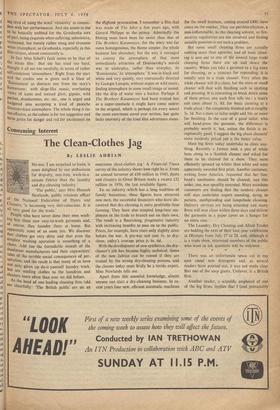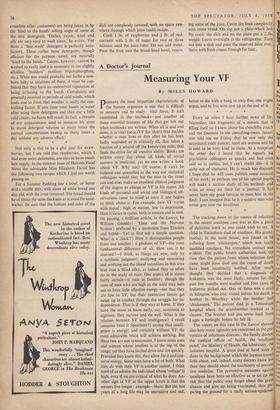Consuming In terest
The Clean-Clothes Jag
By LESLIE ADRIAN No one, I am surprised to learn, is more delighted by our enthusiasm for drip-dry, non-iron, wash-in-a- minute fabrics than the laundry and dry-cleaning industry.
'The public,' says Miss Hannah Newlands, public relations officer of the National Federation of Dyers and Cleaners, `is becoming, very dirt-conscious. It is all very good for the trade.' People who have never done their own wash- ing buy these new easy-to-wash garments and, of course, they launder them at home. But apparently most of us soon tire. We discover that clothes get very dirty and that even the simplest washing operation is something of a Chore , Add too the formidable assault of the deodorant manufacturers and their copywriters' tales of the terrible social consequences of per- spiration, and the result is that many of us have not only given up do-it-yourself laundry work, but are sending clothes to the laundries and cleaners more often than ever we did before. As the head of one leading cleaning firm told me cheerfully : 'The British public' are on an enormous clean-clothes jag.' A Financial Times survey of the industry shows how right he is. From an annual turnover of £10 million in 1945, dyers and cleaners in Great Britain made a record £32 million in 1956, the last available figure.
To an industry which has a long tradition of family businesses, these figures have attracted new men, the successful financiers who have dis- covered that dry-cleaning is more profitable than farming. They have also tempted long-time em- ployees in the trade to branch out on their own. The result is a flourishing, progressive industry with increasing benefits to pass on to the public. Prices, for example, have risen only slightly since before the war, A pre-war suit cost 5s. to dry- clean; today's average price is 6s. 6d.
With the development of new synthetics, the dry- cleaner's job has become highly technical. Some of the new fabrics can be ruined if they are treated by the wrong dry-cleaning process, and the cleaner today must firstly be a textile expert, Miss Newlands tells me.
Apart from this essential knowledge, almost anyone can start a dry-cleaning business. In re- cent years four new, efficient automatic machines for the small business, costing around £400, have come on the market. They use perchlorethylene, a non-inflammable, as the cleaning solvent, so fire- security regulations are not involved and finding suitable premises is not such a problem.
But some small cleaning firms are actually nothing more than agencies, and all basic clean- ing is sent out to one of the several large trade cleaning firms there are up and down the country. When you take a garment to a big store for cleaning, or a raincoat for reproofing, it is usually sent to a trade cleaner. Very often the trade cleaner will dry-clean, but the store or small cleaner will deal with finishing such as spotting and pressing. It is interesting to break down some of these prices, one such firm tells me : a man's suit costs about Is. 8d. for basic cleaning at a trade place : the completely finished job is roughly 3s. 5d. Yet a store or tailor might add 10s. or more for finishing. In the case of a good tailor, who will hand-press the garment, the difference is probably worth it, but, unless the finish is ex- ceptionally good, I suggest the big chain cleaners' more modestly priced job is the better value.
Most big firms today undertake to clean any- thing. Recently a farmer took a pen of white hens along to a Scottish cleaner and asked for them to be cleaned for a show. They were efficiently spruced up whiter than white and were apparently awarded first prize. Another customer, writing from America, requested that her hus- band's tombstone should be cleaned, and this order, too, was speedily executed. More mundane customers are finding that the modern cleaner will also undertake expert mending, dying to pattern, mothproofing and lampshade cleaning. Delivery services are being extended and many firms will now clean within three days and deliver the garments in a paper cover on a hanger for no extra cost.
The Laundry, Dry Cleaning and Allied Trades are holding the next of their four-year exhibitions at Olympia from July 17 to 28, and, although it is a trade show, interested members of the public who want to ask questions will be welcome.• There was an unfortunate space cut in my note about new detergents and, as several readers have pointed out, it was not made clear that one of the soap giants, Unilever, is a British firm.
Another reader, a scientific employee of one of the big firms, implies that I (and presumably countless other customers) am being taken in by the 'kind to the hands' selling angle of some of the new detergents. 'Dishes, rayon, wool and silk are very easy to wash clean,' he writes. 'For them a "fine wash" detergent is perfectly satis- factory. These rather tame detergents, though efficient for the purpose stated, are naturally "kind to the hands." Cotton, however, cannot be washed so easily and it is necessary to use slightly alkaline "builders" (sodium tripolyphosphate, etc.). While one would probably not bathe a new- born baby in solutions of these, it must be con- fessed that they have an undesetved reputation of being irritating to the hands. Complaints are generally received in periods of Cold winds, which leads one to think that weather is really the.con- trolling factor. If you rinse your hands in water after using these detergents and then use a little cold cream, no harm will result. In fact, a chemist of my acquaintance used to immerse his arms in warm detergent solution at many times the normal concentration twenty to thirty times a day without any adverse effect.'
Not only is this to be a glut year for straw- berries, but I am told that raspberries, which I find even more delectable, are also to be in excel- lent supply. In the summer issue of Harrods Food News the admirable Miss Elizabeth David has the following two recipes which I feel are worth passing on.
For a Summer Pudding line a bowl, or better still a soufflé dish, with slices of white bread one day old, with the crust removed. The bread should be of about the same thickness as is usual for sand- wiches. Be sure that the bottom and sides of the dish are completely covered, with no space any- where through which juice could escape.
Cook 1 lb. of raspberries and * lb. of red- currants with lb. of sugar for two or three minutes until the juice runs. Do not add water, Pour the fruit into the bread-lined bowl, reserv- ing some of the juice. Cover the fruit completely with more bread. On top put a plate which just fits inside the diih and on the plate put a 2 lb. weight. Leave overnight in the refrigerator. Turn out into a dish and pour the reserved juice over. Serve with fresh cream. Enough for four.























































 Previous page
Previous page